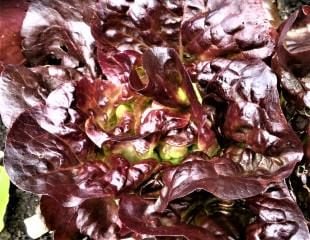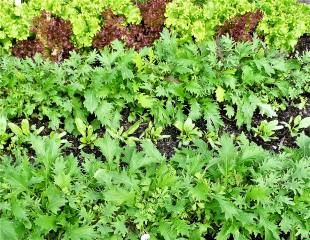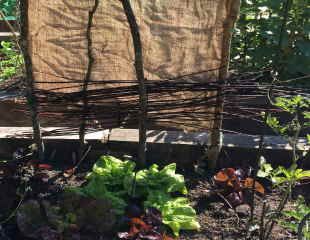


How to Grow lettuce

A quick and easy crop, lettuce is ideal for growing either in containers or in the veg plot. Home grown is so much fresher than the supermarket bags of lettuce, which have a short shelf life. By growing your own lettuce, you can pick and eat lettuce fresh when you want.
Lettuce is one of the few vegetables which grows well, arguably better, in partial shade. Partial shade keeps the lettuce cooler, which helps to prevent bolting, common in hot dry conditions.
This means when planting lettuce, it is important to incorporate some shade. The image left shows a lettuce starting to bolt, which means the inner lettuce instead of being tight, and inside the lettuce, shoots upwards. The problem with that is it becomes very bitter tasting and not really edible.
Space plants according to variety, but plant smaller lettuces and cut-and-come-again varieties closely together to fill gaps in the vegetable plot. Mixing the colours as in the image top right looks effective.
You can grow lettuce late into the season, into September and October, especially if you protect it with a cloche. Lettuce is not hardy but will take a fair degree of cold, so all early and late plants need frost protection. You can also grow in the winter, check out growing Lettuces in Autumn and Winter.
Fancy growing something different? Check out Native British Leaves ' Urban Forager Mix' suitable for containers and patios, all year round seed mix of native salad leaves available at (affiliate link) Suttons.
Growing Lettuce from seed
Lettuce is easy to germinate, although the seed is small to handle it will germinate in temperatures from 10 to 20 degrees. Early spring in March or April is a good time to start lettuce, in a warm area either under glass or with some gentle heat in a propagator. Once germinated, the seedlings, if bunched together, will need thinning, which means reducing by pulling out extra seedlings so that only a few well-spaced seedlings remain and remove the other seedlings which are over crowding the main plants. Plant seedlings outside in late April, early May, and sow Lettuce direct throughout June and July.
A tip when growing lettuce to sow/plant out regularly; fortnightly is a good rule of thumb and easy to remember. By sowing at intervals, you can avoid gluts. Sow the lettuce seed just under the soil surface and always water after sowing. When growing Lettuce, it is important to keep a watch on the small seedings after germination because, if there is a dry spell, the seedlings are prone to drying out and will die.
Lettuce is a shallow rooted vegetable, which makes it ideal for containers. If you are short of space, you can plant in a shallow container provided there is at least 6inches/15 cms soil depth.

Growing lettuce is easy, so tagged green wheelbarrow
Problems when growing lettuce Slugs and Bolting
There are two potential problems when growing lettuce. Slugs and too much heat, causing lettuce to bolt.
Tender lettuce shoots are caviar to the slugs, so protect. Tips on how to beat the slugs- in the veg garden I prefer either organic slug pellets, beer traps and often a combination of the two can be most effective.
Long days of light and heat cause bolting, so it happens in midsummer and during hot, sunny spells. Bolting is hard to avoid, especially if we have a heatwave.
To reduce bolting plant in partial shades, improve the soil to retain moisture and mulch once the small seedlings or plants are established. Also, regular sowing or planting every fortnight should mean there is another crop to come along soon.
Illustrated below is a lettuce which has bolted. The lettuce is growing upwards and in a conical tower shape instead of a rounded shape. Below also are some makeshift shade structures I put up during a heatwave, a large golf umbrella (watch out for windy weather,) and safer, hessian sacks. It was too little and too late, and some of the lettuce crop bolted. This was an exceptionally hot spell of weather 29 C plus no rain and its inevitable there will be casualties.
Usually I grow lettuces with little or no slug attention, because of two factors. An abundance of frogs in the garden and the use of raised wood beds made from railway sleepers, which are quite rough. Slugs dislike sliding over rough surfaces.

Best Lettuce to grow
The RHS has released the results of their recent 2017 trial of coloured lettuces, which information is always handy to know when selecting which varieties to grow. They planted numerous varieties trialled at RHS Wisley in Surrey and there was quite a change around with only one cultivar 'Amaze' keeping its AGM. Having grown 'Amaze' many times, it is really good and is illustrated top left. Other lettuces which did well in the trials and AGM are: 'Edox' which is said to be slow to bolt; 'Feska'is a frilly lollo rossa type; 'Pigale' compact with centre heart; ' Rosdale' is more upright and similar to a cos style of lettuce; 'Sahim' is greener in the heart turning red at the outer leaves, 'Saxo' is all red and 'Navara' is similar both oak leaved types.
One of the plus points about growing red lettuces is not only are they great to eat, but they look really attractive, especially planted alongside green lettuce as illustrated in the above centre image.
